OVERVIEW
Project type: Feasibility, Concept Select & pre-FEED
Customer: Rockhopper Exploration plc
Location: Falkland Islands
CHALLENGE
The Falkland Islands are situated in the South Atlantic, about 480 km from South America, with a population of around 3,200. The three largest industries are fishing, agriculture and tourism. Commercial industries and infrastructure are limited due to the remote location. The area is environmentally pristine and sensitive.
Rockhopper has discovered the first commercial oil reserves here. Extracting and bringing the difficult oil to market as a commercial enterprise requires special consideration of the fluids, the remote and frontier location, and the metocean conditions; whilst recognising the political, social and environmental sensitivity of the region.
UNDERSTANDING
The Sea Lion Field is located 200km North of mainland Falkland Islands, in a maximum water depth of 450m – too deep for most bottom founded concepts and too shallow for some floating concepts, in the relatively harsh and persistent metocean conditions.
The field is characterised by the viscous, waxy, high gel strength nature of the fluids demanding some form of well artificial lift and reservoir pressure maintenance. Keeping the fluids mobile and warm helps maintain productivity at the levels required for commerciality; despite the impact of potential corrosion on materials. Alternative artificial lift mechanisms including ESPs, HSPs, gas lift or seabed mounted multiphase pumps would be required to deliver the oil to the processing facility.
Subsea configurations were also developed that recognised the remoteness of the field and the number of long distance mobilisations that might be required for the installation vessels; whilst satisfying the requirements of flow assurance.
Offloading of oil, particularly with respect to the metocean conditions and the distance to market meant that serious consideration had to be given to offloading uptime and confirmation of whether offloading to trading tankers would be a safe and reliable operation.
SOLUTION
We applied our world class proprietary process to create options for concept identification, screening and selection to provide the optimal development solution; taking account of field development costs, availability, operating envelopes, contracting strategies and business risks.
Specialist fluid characterisation and flow assurance expertise was required to fully understand the impact of dealing with the difficult fluids: including full thermohydraulic analysis of wellbores with hot water driven hydraulic submersible pumps in each of the wells – an industry first.
Applying heat to the subsea system during normal operations and during shutdown/restart meant that new, unproven technologies had to be considered which included the heating of jumpers and manifolds.
Keeping flowline warm and recirculation of corrosive components in the subsea system required materials management that involved potentially new materials, and liaison with manufacturers.
RESULTS
From initial engagement in September 2010, we worked closely with Rockhopper from early feasibility to pre-FEED over a period of 2 years.
Subsea tie-backs to the Falkland Islands were quickly discounted due to the flow assurance difficulties, as well as the impact on the islands.
The optimum concept for SeaLion, that satisfied all the project drivers for Rockhopper, was found to be a leased FPSO with subsea tiebacks, the wells being supported by hot water driven hydraulic submersible pumps. Reservoir pressure was to be maintained by hot water injection. Offloading of oil to trading tankers enabled worldwide markets to be easily accessible with an acceptable offloading uptime.
All the deliverables required to enter into FEED were prepared, including a novel functional specification for the entire system based on “functionality” using Norsok nomenclature.
